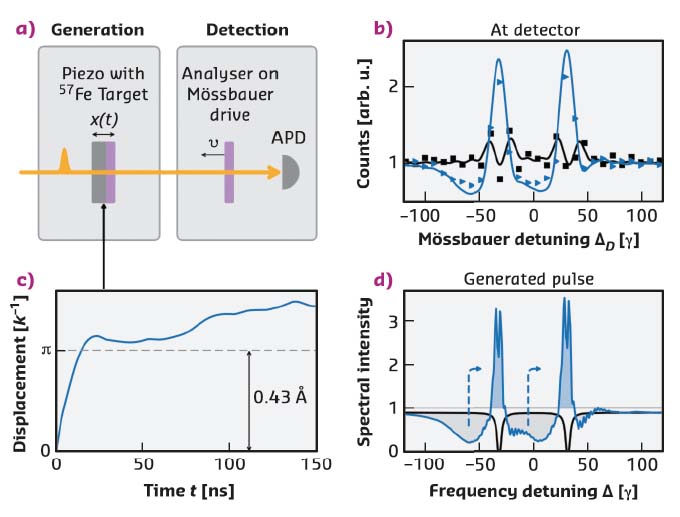- Home
- Users & Science
- Scientific Documentation
- ESRF Highlights
- ESRF Highlights 2017
- Matter at extremes
- Sudden shifts sharpen X-ray pulses
Sudden shifts sharpen X-ray pulses
Nuclear resonance techniques use only a narrow fraction of the X-ray spectrum. By squeezing off-resonant photons onto resonance via precisely controlled motion of a resonant target, the number of resonant photons in an X-ray pulse has been significantly increased. The enhanced intensity permits previously unfeasible experiments and opens the door for new experimental possibilities.
Narrow X-ray resonances such as those of Mössbauer nuclei form the basis for a broad range of experiments based on high-precision spectroscopy and are a decisive component for novel applications in the realm of X-ray quantum optics [1]. However, the spectra of the short pulses delivered by modern X-ray sources are orders of magnitude broader than the narrow resonances and only a tiny fraction of the available photons interacts resonantly with the sample, while the vast majority produce an off-resonant background. This restricts the achievable spectral, spatial and temporal resolution for commonly-used narrow resonances, preventing experiments with the sharpest available resonances.
To overcome this, a novel method was developed to amplify the spectrally broad X-ray pulses of state of the art X-ray sources in a narrow spectral region. Unlike with monochromators, the undesired off-resonant photons are not simply removed, but converted into resonant ones.
Pictorially, the method works like a mechanical digger that shapes a hill out of a flat landscape by removing earth at the sides and piling it up. Analogously, the new method removes photons in off-resonant spectral regions, and piles them up in a narrow resonant spectral region. In the experiments performed at ID18 and P01 (PETRA-III, DESY), the role of the digger is taken by a piezoelectric material that performs specific motions upon precisely characterised and controlled electric signals (Figure 31a). The “photon shovel” is formed by a thin iron absorber foil on the piezo, which temporarily stores X-ray photons while it performs its motion. The operation of the piezoelectric photon shovel exploits the Mössbauer effect: nuclei such as 57Fe used in this experiment, when embedded in a solid-state environment, can absorb and emit X-ray photons essentially without recoil.
The working principle of the photon shovel is based on interference effects: incoming resonant X-ray photons either pass through the sample without interaction, or are temporarily absorbed (Figure 31a). This absorption and re-emission leads to a phase shift, such that the scattered photons destructively interfere with the non-interacting part. As a consequence, a dip due to absorption is observed in the spectrum. If instead the absorber foil is displaced by half the resonant wavelength after the non-interacting part has passed the sample, but before most absorbed photons have been re-emitted, the destructive interference can be converted into constructive interference. This way, the number of resonant photons increases. The motion not only affects the resonant light, but conversely also attenuates the X-ray pulse around the resonance. Overall, the enhancement of the resonant photon number is thus achieved by shovelling off-resonant photons onto the resonance (Figure 31d).
 |
|
Fig. 31: a) Incoming X-ray pulses are sharpened via an iron foil mounted on a piezo drive, and subsequently their spectrum is detected. b) Experimental data together with theoretical fits. c) The piezo is displaced by 0.43 Å, half the resonant wavelength. d) Normalised X-ray spectra behind the piezo. Usual absorption of the magnetically split nuclear resonance is shown (black). The spectrum for the motion in (c) clearly exhibits the conversion into enhancement on resonance (blue). |
Experiments were performed with samples enriched in the isotope 57Fe with its nuclear transition at 14.4 keV. The displacement of the absorber foil was controlled to less than a tenth of a nanometre, and took place within a few nanoseconds (Figure 31c). The reconstruction of these motions from the measured spectra constituted a considerable part of the analysis. An enhancement by a factor of up to 4 was observed for the number of photons on resonance as compared to the incoming photon number. Theoretical calculations suggest that an enhancement by a factor of 10 should be feasible with an optimised absorber foil and corresponding motion, limited only by additional electronic attenuation due to the photon-shovel material. In a subsequent experiment, the possibility for further enhancements with multiple shovels was successfully demonstrated.
In future, this new technique could be deployed in the routine operation of beamlines at synchrotrons and free-electron lasers. The increased intensity results in shorter measurement times and enables measurements with presently too low signal rates. Also, the higher signal rates translate into better energy and spatial resolution. Using different displacement patterns enables a more general manipulation of the X-ray spectra [2]. Furthermore, the mechanical control of X-ray-matter interactions could become a valuable tool in X-ray quantum optics, alleviating the need for additional X-ray control fields in certain settings. Finally, the technique also opens the possibility to track motions on atomic length scales in a wide range of scientific and technological applications.
Principal publication and authors
Spectral narrowing of X-ray pulses for precision spectroscopy with nuclear resonances,
K.P. Heeg (a), A. Kaldun (a), C. Strohm (b), P. Reiser (a), C. Ott (a), R. Subramanian (a), D. Lentrodt (a), J. Haber (b), H.-C. Wille (b), S. Goerttler (a), R. Rüffer (c), C.H. Keitel (a), R. Röhlsberger (b), T. Pfeifer (a) and J. Evers (a), Science 357, 375-378 (2017); doi: 10.1126/science.aan3512.
(a) Max-Planck-Institut für Kernphysik, Heidelberg (Germany)
(b) Deutsches Elektronen-Synchrotron DESY, Hamburg (Germany)
(c) ESRF
References
[1] B.W. Adams et al., Journal of Modern Optics 60, 2 (2013)
[2] C. Ott et al., Science 340, 716-720 (2013)



